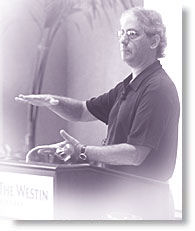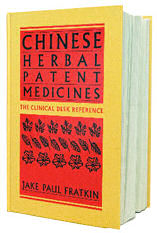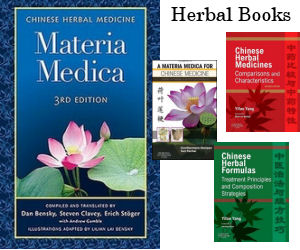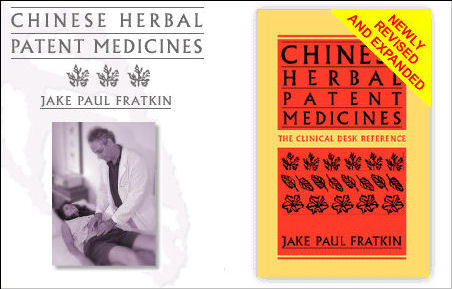Acupuncture & TCM Articles

Articles by Jake Paul Fratkin, OMD, LAc
Jake Fratkin, OMD, LAc, has been in the practice of Oriental medicine since 1978. Following undergraduate and graduate training at the University of Wisconsin in Chinese language and philosophy and pre-medicine, he pursued a seven-year apprenticeship in Japanese and Korean style acupuncture with Dr. Ineon Moon and a two-year apprenticeship in Chinese herbal medicine with Drs. Zhengan Guo and Pak-Leung Lau in Chicago. He also spent a year in Beijing hospitals interning in advanced herbal medicine, specializing in gastrointestinal and respiratory disorders, and pediatrics.  Dr. Fratkin is the author of several books, including Chinese Herbal Patent Medicines: The Clinical Desk Reference, and is the editor-organizer of Wu and Fischer's Practical Therapeutics of Traditional Chinese Medicine. In 1999, he was named the "Acupuncturist of the Year" by the American Association of Oriental Medicine.
Dr. Fratkin is the author of several books, including Chinese Herbal Patent Medicines: The Clinical Desk Reference, and is the editor-organizer of Wu and Fischer's Practical Therapeutics of Traditional Chinese Medicine. In 1999, he was named the "Acupuncturist of the Year" by the American Association of Oriental Medicine.
Chinese Herbal Patent Medicines: The Clinical Desk Reference
Hardback book, 1198 pages. This volume covers 1360 products, including 550 GMP level products and all of California FDB analysis on 505 products. Includes information on endagered animals, heavy metals, and pharmaceuticals. The text is organized into 12 groups, with a total of 109 chapters and includes material by Andrew Ellis, Subhuti Dharmananda, and Richard Ko. Over 80 pages of full-color photos (with English and Chinese cross-reference). Fully indexed.
TWO CASES OF HYPERTHYROIDISM
Hyperthyroidism is not often seen in the clinic, but Chinese herbal medicine can be very helpful. I want to talk about two cases involving hyperthyroidism. The first was a 44 year-old German woman who lives in my town. While in Germany, she had an illness manifesting as a low-grade fever (99.2º to 100.5º F.), a painful lump on her thyroid, and pain when swallowing. She was originally diagnosed as having a “light hyperthyroid constellation’ with a lowered TSH but normal thyroid antibodies. A referral to an endocrinologist revised the diagnosis to “subacute De Quevain´s thyroiditis’, a possible viral condition that can last in an acute phase for two to three months, with residual thyroid malfunction up to eighteen months. The residual malfunction usually shows as hypothyroid. The German physician recommended prednisone treatment for six weeks with ibuprofen for the pain, and suggested that perhaps a complete thyroidectomy might be necessary. This is certainly extreme, whereas most physicians would treat it with NSAIDs and possibly steroids like prednisone, but rarely surgery. My patient replied that she would return to America, and have her TCM herbal doctor work on it. The doctor laughed, and said nothing would help besides his recommendations.

The patient arrived two weeks after the initial diagnosis. She had a constant and severe pain radiating from her thyroid to her jaws and lower teeth, with difficulty and pain swallowing. She also had episodes of heart palpitations and tachycardia, poor appetite, fatigue, and extended periods of “jitteriness’. Her temperature was 100.1º F. She brought her blood lab work from Germany, showing a very low TSH of .02, and an IgE of 561 (normal range is <100). Free T4 and T3 levels were normal. She had not taken the prednisone, but was using 400 mg. of Ibuprofen every 3-4 hours.
Her pulses were rapid, thin and floating, and her tongue show a slight glossy red. Her pulses and tongue would indicate treating yin deficiency heat, but I decided to concentrate on her clinical picture of having heat toxins in her throat with a lump on her thyroid. I put her on two patent medicines, Pu JiXiao Du Yin and NeiXiao Luo Li Wan. The first formula is used for heat toxins accumulating in the throat, and originally acted as a medicine for what was probably diphtheria in the 14th century.1 The second formula is used for goiters and lumps
in the thyroid.2
I kept her on these medicines for five weeks, while treating her with acupuncture weekly using Japanese Meridian Therapy. By the end of the third week, she reported improved appetite, absence of heart palpitations and tachycardia, reduction in jaw pain, and improvement in swallowin g. Her fatigue remained. On the fifth week of treatment, her thyroid lump was gone, and she continued to improve in terms of sleep quality, less anxiety, and only occasional periods of tachycardia. We did another blood draw. He IgE was now 72 (normal range 0-114 KU/L), but her TSH was still quite low. Now that the lump was gone, I changed her formula now to Zhi Bai Di Huang Wan3 combined with Chuan Xin Lian4, both as patent medicines. The first formulas treats yin deficiency heat, while the second addresses heat toxins in the throat, lymph and blood. This was continued for two more weeks.
The patient reported feeling “back to normal’ and discontinued treatment. There was no subsequent follow-up, and I do not know the outcome status of her TSH level or thyroid function. I do feel, however, that the herbal and acupuncture interventions brought the acute phase to definite conclusion. I believe that a virus was active during this time, and that the use of antiviral herbs in Pu Ji Xiao Du Yin and Chuan Xin Lian were important.
The second case involved a woman, 40 years old. On March 27, 2006, she complained of having significant episodes of palpitations daily, with feelings of “heating up’. I recommended doing a thyroid panel. Based on pulses (thin, floating, rapid, but also wiry) and tongue (glossy red, especially in the distal third), I made the differentiation of deficiency of yin with fire, liver stagnation with heat, and deficiency of heart yin. I decided to create a formula based on combining herbs from Da Bu Yin Wan5, Jia WeiXiao Yao Wan6, and Bu Nao Wan.7
The formula was the following: bai zi ren (Semen Biota Orientalis) 11 g.; long gu (Os Draconis) 11 g., suan zao ren (Semen Zizyphus Spinosa) 11 g., fu ling (Sclerotium Poria Cocos) 9 g., gou qi zi (Fructus Lycium) 8 g., chai hu (Radix Bupleurum) 8 g., zhi mu (Radix Anemarrhenae Asphodeloidis) 8 g., zhi zi (Fructus Gardenia Jasminoides) 8 g., huang bai (Cortex Phellodendron) 8 g., mu dan pi (Radix Cortex Moutan) 8 g., bai shao yao (Radix Paeonia Lactiflora) 8 g., dang gui (Radix Angelica Sinensis) 7 g.; and yuan zhi (Radix Polygala) 7 g. These herbs were prepared into a 4 oz. alcohol-extracted tincture and ready for her 3 days later.8 Dosage was one teaspoon, twice a day, with a little boiling water.
On March 28th, the results of the thyroid panel came in: TSH at .004 (it should be between 1.5 and 3.0), with a T4 of 2.03, with elevated thyroid antibodies. By April 4th, after four days of herbal tincture, she reported that she was feeling better: less palpitations, less internal heat, better sleep. She was given Japanese Meridian acupuncture once weekly, and her symptoms gradually improved. The same formula was continued. At the end of three months, her thyroid TSH had began to normalize, while her T3 came within normal ranges. She discontinued treatment at a total of three months.
On August 10th, she returned, complaining of goiter and hoarse voice. The goiter was visibly noticeable as a large bulge over her thyroid. This is related to her hyperthyroidism (Graves´ Disease), and I felt that if we had continued treatment, we could have prevented the development of goiter. I gave her the patent medicine Ji Sheng Ju He Wan9 and kept her on this for two months. She reported improvement in reduction of the goiter and improvement in her voice. On October 16th, I took the same formula and made it into an alcohol-extracted tincture. She took this for one month, and reported complete reduction of the goiter.
Follow-up treatment continued into the following May. She went through several differentiations, including yin deficiency with heat and liver stagnation. The herbal products I used included Zuo Gui Wan10, Ecliptex (Health Concerns) and ChaiHu Shu Gan Wan11. By May, she felt completely free of hyperthyroid symptoms and goiter problems. Her TSH had completely returned to normal range.
Conclusions. These two cases point out some interesting facets of a modern clinical practice. First, that patent medicines are quite effective on their own. Criticism that they are weak and underpowered doesn´t bear up to clinical scrutiny. Second is my observation that alcohol-extracted tinctures are as effective as other methods, including soup (tang). I have been using this method since 1987 with significant clinical success. And finally, following cases with appropriate laboratory tests aid our practice. We use them to confirm Western diagnosis and to monitor improvement. When I hear criticism that this is not “real’ Chinese medicine, I reply that in China all TCM students are trained in lab diagnosis, and that TCM doctors in hospital settings use them frequently. More knowledge and information is a good thing, not a bad thing. What distinguishes our practice is our therapies: acupuncture and herbal medicine. We can combine the best aspect of Western medicine (diagnosis, physiology and disease etiology) with the best aspect of Traditional Chinese Medicine: more effective treatment without toxic or dangerous side effects.
1 Pu JiXiao Du Yin, recorded in the wei sheng bao jian, Precious Mirror of Health’ by Luo Tianyi, Yuan dynasty. For ingredients of this formula and others listed below, see Fratkin, Chinese Herbal Patent Medicines, The Clinical Desk Reference, Shya Publications, 2001; Ellis, Notes From South Mountain, Thin Moon Publishing, 2003; or other formula books.
2 Nei Xiao Luo Li Wan, ÒInternal Disperse Scrofula Pills, Gu Shicheng in Yang Yi Da Quan, Complete Works for Treatment of Sores, 1 7thcentury.
3 Zhi Bai DI Huang Wan, Gardenia, Phellodendron, Rehmannia Pills, Wu Qian et al, Yi Zhong Jin Jian, Golden Mirror of the Medical Tradition, 1 742.
4 Chuan Xin Lian, modern Chinese patent medicine. (See Fratkin, above, p. 82).
5 Da Bu Yin Wan, “Great Tonify Yin Pill, Zhu Zhenheng (Danxi), in Dan XiXin Fa, Teachings of (Zhu) Danxi, 1481.
6 Jia Wei Xiao Yao San, “Added Ingredients Free and Relaxed Powder, Wang Kentang in Zheng Zhi Zhun Sheng, Standards Of Patterns And Treatments, 1 602.
7 Bu Nao Wan, “Tonify Brain Pill, modern patent medicine. See Fratkin, p. 742.
8 I have been extracting Chinese herbs into alcohol-based tinctures since 1 987. I have heard criticism that alcohol tinctures could not be used in cases of internal heat or deficiency heat, but the results of this case, as well as many others, disproves this idea. I do recommend a small amount of boiling water to dispel the alcohol. My method is described on my website at http://drjakefratkin.com/pdf/mae.pdf
9 Ji Sheng Ju He Wan, “Abundant Life Tangerine Seed Pills, Yan Yonghe in Ji Sheng Fang, Formulas from Aid the Living, 1 253.
10 Zuo Gui Wan, “Left Return Pills, Zhang Jiebing, Jing Yue Quan Shu, Collected Treatises of (Zhang) Jing-Yue, 1 624.
11 Chai Hu Shu Gan Wan, “Bupleurum Dredge Liver Pill’, Zhang Jiebing in Jing Yue Quan Shu, Collected Treatises of (Zhang) Jing-Yue, 1 624. Also attributed to Zhang Jiebing in Jing Yue Quan Shu, Collected Treatises of (Zhang) Jing-Yue, 1 624.
 
|
